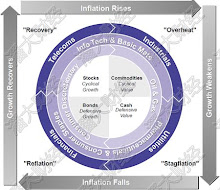
VIX is calculated and disseminated in real-time by the Chicago Board Options Exchange. It is a weighted blend of prices for a range of options on the S&P 500 index. The formula uses a kernel -smoothed estimator that takes as inputs the current market prices for all out-of-the-money calls and puts for the front month and second month expirations. The goal is to estimate the implied volatility of the S&P 500 index over the next 30 days.
The VIX is the square root of the par variance swap rate for a 30 day term initiated today. Note that the VIX is the volatility of a variance swap and not that of a volatility swap (volatility being the square root of variance). A variance swap can be perfectly statically replicated through vanilla puts and calls whereas a volatility swap requires dynamic hedging. The VIX is the risk neutral expectation of S&P volatility over the next 30 calendar days. The VIX is quoted on an annualized variance basis.
The VIX is quoted in terms of percentage points and translates, roughly, to the expected movement in the S&P 500 index over the next 30-day period, on an annualized basis. For example, if the VIX is at 15, this represents an expected annualized change of 15% over the next 30 days; thus one can infer that the index option markets expect the S&P 500 to move up or down over the next 30-day period. That is, index options are priced with the assumption of a 68% likelihood (one standard deviation) that the magnitude of the S&P 500's 30-day return will be less than 4.33% (up or down).
The price of call options and put options can be used to calculate implied volatility, because volatility is one of the factors used to calculate the value of these options. Higher (or lower) volatility of the underlying security makes an option more (or less) valuable, since there is a greater (or smaller) probability that the option will expire in the money (i.e. with a market value above zero). So a higher option price implies greater volatility, other things being equal. Despite its sophisticated composition, however, the predictive power of VIX is similar to that of simpler measures, such as past volatility (see graphs on the right).
Investors believe that a high value of VIX translates into a greater degree of market uncertainty, while a low value of VIX is consistent with greater stability.
Although the VIX is often called the "fear index," a high VIX is not necessarily bearish for stocks. Instead, the VIX is a measure of fear of volatility in either direction, including to the upside. In practical terms, when investors anticipate large upside volatility, they are unwilling to sell upside "call" stock options unless they receive a large premium. Option buyers will be willing to pay such high premiums only if similarly anticipating a large upside move. The resulting aggregate of increases in upside stock option "call" prices raises the VIX just as does the aggregate growth in downside stock "put" option premiums that occur when option buyers and sellers anticipate a likely sharp move to the downside. When the market is believed as likely to soar as to plummet, writing any option that will cost the writer in the event of a sudden large move in either direction may look equally risky. Hence high VIX readings mean investors see significant risk that the market will move sharply, whether downward or upward. The highest VIX readings occur when investors anticipate that huge moves in either direction are likely. Only when investors perceive neither significant downside risk nor significant upside potential will the VIX be low.








